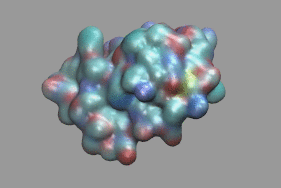
June 25, 2013, by Charlie Laughton
Playing snooker with jelly
If you have a snooker app on your smartphone then you have a piece of software there that’s not a million miles away from that which is increasingly used to design new drugs [1].
Like a never-ending game of high-speed snooker,the molecules in our body – proteins, DNA, lipids, sugars, etc. – are a state of constant motion and collision; it’s what keeps us alive. When we design a drug we are looking to make a molecule that, when added to this incredibly complex and dynamic soup, will just slightly modify the behaviour of one or two components of the mix – a tall order. We need computer simulations to help us do this because firstly molecules are too small to be directly visualised in the way we need by any experimental technique, and secondly because in a computer we can make a model of any molecule we like – real or hypothetical – just with a few clicks of a mouse so hopefully we can home in on the perfect drug quickly and with minimum expense.
This technology is at the heart of a lot of the research we do, so I thought I’d use this post to talk a bit more about how it works, illustrate how challenging it is, and what some of the problems are that we and many others work on to improve this powerful but still far from perfect tool for drug discovery.
Let’s start with that snooker app. At its heart it uses Newton’s equations of motion to calculate how fast and in what direction the cue ball moves when you hit it, and what happens over time as it collides with the other balls on the table, they ricochet off the cushions, collide with other balls, etc. This sounds like a good start for our “computational microscope”, where do we go from here?
Firstly make each ball represent a molecule and call the whole thing “Molecular Dynamics” (MD for short) instead of snooker. Easy! Unfortunately we are not quite there yet…
Molecules aren’t all the same size, so we need to make some of the balls bigger than others. Also snooker is played on a flat table so it’s a 2D-game. But molecules float about in three dimensions. OK – from a maths point of view neither of these is a big deal, the snooker app won’t need much tweaking to cope with these issues.
Next, we need to take into account that molecules in general are not spherical, they have all sorts of complicated bumpy shapes. And they are not hard either, but more like lumps of jelly. That makes things much more challenging – working out what happens when these crash into each other is going to take a whole lot more chewy sums than was the case for snooker balls.
And now a further complication: the molecules don’t always just bounce off each other because sometimes they are sticky. This is a vital property because it’s what enables them to spontaneously assemble into complex functional things like cells. Getting this right in the computer model is very hard because, to be honest, we don’t fully understand all the forces at work here, and certainly don’t know how to represent them in computer code in a completely accurate way. But we can do a pretty good job if we write somewhere between one hundred and one thousand times more lines of code than were needed to calculate the forces for the snooker balls. Oh, and I forgot one thing: there are only a maximum of 22 snooker balls on the table that your app has to track, but an MD simulation might feature thousands and thousands of molecules.
So there you have it – molecular dynamics is like snooker, only played in three dimensions with thousands of differently sized irregular lumps of somewhat sticky jelly. The simulations are incredibly compute-intensive and very hard to do completely accurately, but they can give amazing insights for drug design that just can’t be got any other way.
[1] Drug Discovery gets an Upgrade. Jonathan D Rocoff, Wall St Journal, 2013.

How significant would the electrostatic potential properties be of the the drug molecule and the target protein compared to the steric properties?
It varies a lot, depending on what protein target and which drug you are looking at. And it’s something that still gets argued about by the theoreticians; to work it out you typically have to look at small differences between big numbers – a very slight error in the calculation of one of those (which as I explain in the post is quite likely) can lead to you jumping to quite the wrong conclusion.
For my PhD, I used steric and electrostatic alignment of a series of anti-inflammatory agents, then calculated a similarity index for each molecule (compared to the most active in the series) and correlated this with their biological activities. A few years later, I used SYBYL’s Comparative Molecular Field Analysis to carry out a similar study on a group of pesticides, for Wellcome Environmental Health (as was).
Yes – these methods can often work better than you might expect (based on what I said before), because you are comparing a series of molecules against each other so with a bit of luck the systematic errors inherent in the calculations get cancelled out and the trends you predict end up being quite accurate.